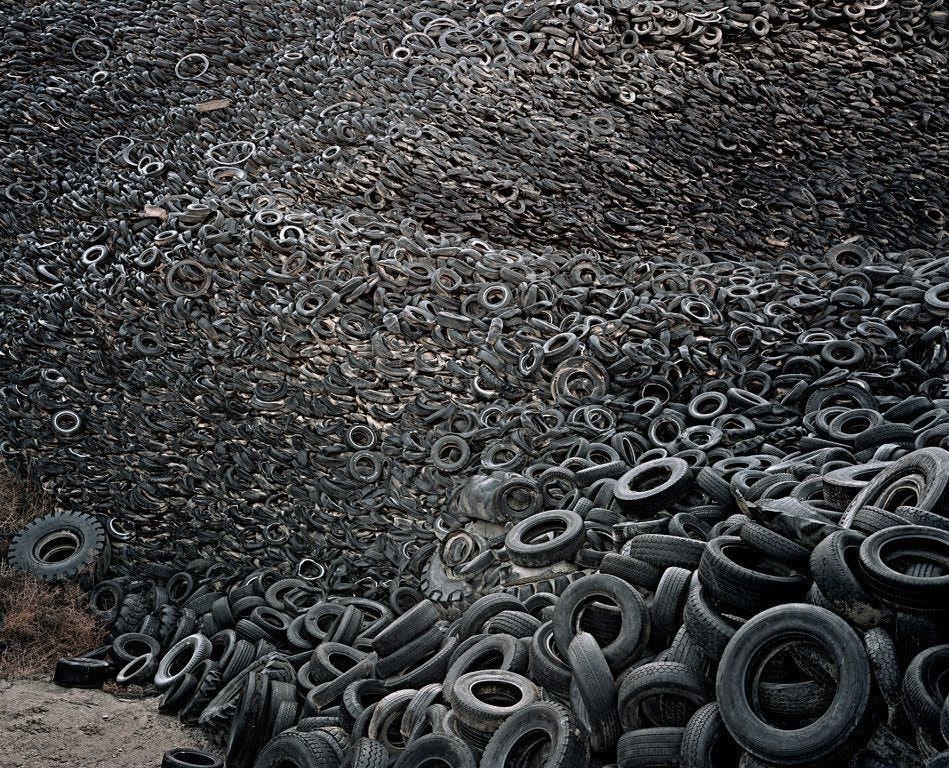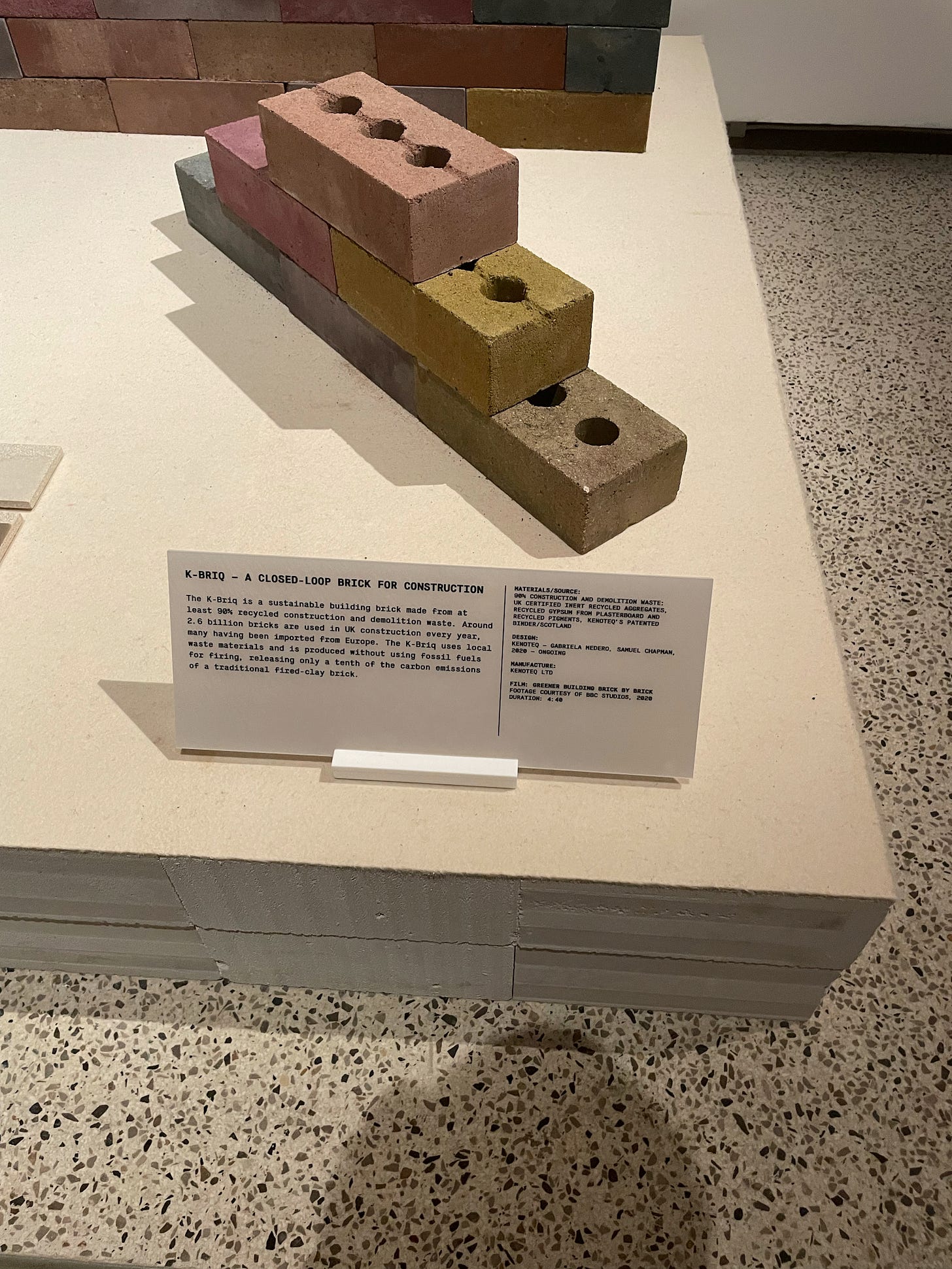When Martha, my eldest visited last week, she suggested a museum. I think she was keen to retrace old steps. After all, it wasn’t that long ago, when I’d bundle the 3 of them into a car on a Saturday morning and head into London to visit the Science or Natural History Museum. We even tried the V&A once because the corridors were a lot clearer and there was the promise of a sandwich in their magnificent refectory washed down with a posh, Sicilian lemonade or ginger beer.
A poignant new exhibition
The exhibition at the Design Museum, Waste Age: What Can Design Do?, is well-timed to resonate with COP26 in Glasgow this year and remains open to the public until 20 February, 2022.
The exhibition initially guides you through the inconvenient consequences of becoming a throw away society, take, make and waste, and the problem which this is now causing the world and our climate.
What problem?
The world now produces 2 billion tonnes of rubbish every year, seven times the weight of the world’s adult population. Only 15% is recycled. Worst still, the waste we produce is still growing, projected to increase to 3.4 billion tonnes by 2050 if we don’t change.
It surely doesn’t help when heads of state like the UK’s Bertie Booster, decide to tell school children that recycling is a red herring in the fight to save the planet. This is Johnson ignorance on an unprecedented scale.
Who are the culprits?
I wanted to know which countries were abusing our planet the most? The exhibition preferred to talk regionally, so I looked elsewhere and was delighted to discover, Sensonseo’s Global Waste Index 2019. Sensonseo are a smart waste management company which operates in 60 countries. They independently survey countries scoring them on waste per capita, percentage recycled, incineration, landfill, open dump and unaccounted for. In terms of disposal, everything after incineration is considered negative.
Turkey, Latvia and New Zealand are the top 3 worst offenders?
Turkey, open dumps nearly all its waste and New Zealanders generate a lot of waste per capita which all goes to landfill. They don’t recycle. The biggest generator of waste per capita is the US. Each citizen, produces on average 808kg per year nearly double that of a Japanese citizen, but they recycle more than most. Only Iceland and Germany recycle more than the US. The UK sits in the middle. Waste generated is lower than many but we need to up our recycling game. The top ranked country is South Korea, followed by Sweden then Japan.
What sort of rubbish?
44% of global waste and the biggest contributor, more than double everything else, is food and green waste (green means garden, manure, organic), producing greenhouse gases (carbon dioxide, methane) in landfill. Paper and cardboard is second at 17%, other 14% ? then plastic 12%.
The good ol’ US of A
Verisk Maplecroft, a global risk-assessment and consulting firm’s report in 2019, is less flattering about the US. The country accounts for 4% of the global population but generates 12% of the world’s rubbish. Not only is it the sheer volume which is eye watering compared with other developed nations, the US has also been accused of blocking efforts to limit plastic waste, including a ban on single-use bottles and bags.
Plastic is made from crude oil and lasts from 450 years to forever. 40% of it is only used once. 8 million pieces of plastic reach the oceans every day. It’s the equivalent of the bin man’s lorry, dumping a truck load of plastic every minute.
Dark Waters
I recently watched the 2019 film, Dark Waters, which dramatised the story of a lawyer, Robert Bilott’s fight with the chemical manufacturing company DuPont, who contaminated a town with unregulated chemicals.
I shouldn’t have been but I was shocked by the reminders time and again in the film that DuPont only care about one thing, shareholder profits, at any cost. Especially poignant was a reference Bilott, (well played by Mark Ruffalo) makes to a document which refers to receptors. He asks the CEO of DuPont whether he knows what they are? It turns out that receptor is the word DuPont chose to use to refer to human beings. The guinea pigs, their employees and others, who were developing cancers and birth defects as a result of consuming PFOA or C8, a man-made forever chemical which can never breakdown in the environment or you.
”A colossal failure in climate leadership in the year of Cop26”
These are the words that Mel Evans, Greenpeace used to describe the UK government’s granting of further North Sea licences to continue exploration for reserves of oil and gas. Instead of banning them like Denmark and France, this government argues that it’s about protecting the 40,000 jobs in the North Sea. It’s lazy, unforgivable and ignores the real need and desire to create a new strategy which focuses on retraining and redeploying thousands of workers into the renewable energy sector. I’m sure BP and Shell are sitting there quietly like DuPont previously, looking forward to delivering another upbeat shareholder statement.
Great designers are thinking about precious waste
The exhibition highlights designers who are starting to analyse the properties of discarded materials for new potential. The priority is to consume less, repair and reuse what we have and recycle what is discarded. These habits move society towards a circular economy rather than the current linear one.
It was encouraging to see the exhibition littered with great ideas happening now. The endless flow rocking chair is a 3-D printed design made from old fridges.
25 million tonnes of cotton and viscose goes to landfill every year. Swedish manufacturer Renewcell has developed Circulose, recovered from warn out clothes, used to make new ones.
Nucycl is a new fabric created from chemical recycling technologies. It can be regenerated multiple times without any loss of quality, creating the infinite hoodie in this case.
These Adidas trainers only use recycled plastic. The upper is rescued from deep sea fishing nets, the rest from plastic washed up on the coastline of the Maldives. This is a collaboration between Parley for the Oceans and Adidas and has happened because the Maldives’ government commissioned Parley to help manage their marine plastics pollution issues.
The K-Briq is a great example of a closed loop system. 90% of the brick is made from local, recycled demolition and construction material in the UK. 2.6 billion bricks are used in the UK every year and many are imported from Europe. This brick doesn’t go through a traditional kiln process and consequently only creates 10% of the carbon emissions.
I wasn’t the only one taking pictures. Martha expects to include content from the exhibition in her lesson plans this year as she trains to be a teacher. Education is the way forward, especially if we want to right the wrongs that continue to be committed. Let’s hope there’s time.









